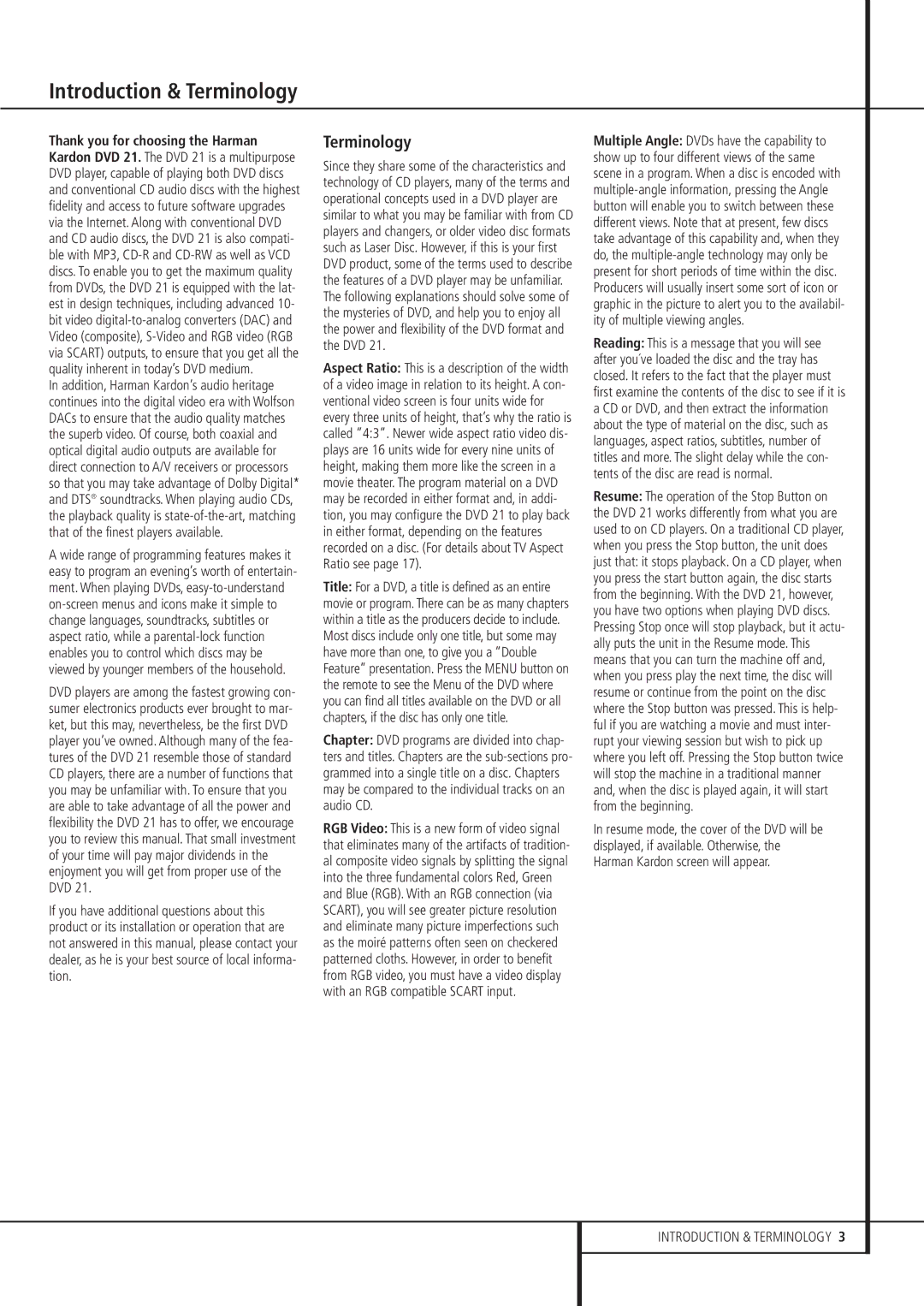
Introduction & Terminology
Thank you for choosing the Harman Kardon DVD 21. The DVD 21 is a multipurpose DVD player, capable of playing both DVD discs and conventional CD audio discs with the highest fidelity and access to future software upgrades via the Internet. Along with conventional DVD and CD audio discs, the DVD 21 is also compati- ble with MP3,
In addition, Harman Kardon’s audio heritage continues into the digital video era with Wolfson DACs to ensure that the audio quality matches the superb video. Of course, both coaxial and optical digital audio outputs are available for direct connection to A/V receivers or processors so that you may take advantage of Dolby Digital* and DTS® soundtracks. When playing audio CDs, the playback quality is
A wide range of programming features makes it easy to program an evening’s worth of entertain- ment. When playing DVDs,
DVD players are among the fastest growing con- sumer electronics products ever brought to mar- ket, but this may, nevertheless, be the first DVD player you’ve owned. Although many of the fea- tures of the DVD 21 resemble those of standard CD players, there are a number of functions that you may be unfamiliar with. To ensure that you are able to take advantage of all the power and flexibility the DVD 21 has to offer, we encourage you to review this manual. That small investment of your time will pay major dividends in the enjoyment you will get from proper use of the DVD 21.
If you have additional questions about this product or its installation or operation that are not answered in this manual, please contact your dealer, as he is your best source of local informa- tion.
Terminology
Since they share some of the characteristics and technology of CD players, many of the terms and operational concepts used in a DVD player are similar to what you may be familiar with from CD players and changers, or older video disc formats such as Laser Disc. However, if this is your first DVD product, some of the terms used to describe the features of a DVD player may be unfamiliar. The following explanations should solve some of the mysteries of DVD, and help you to enjoy all the power and flexibility of the DVD format and the DVD 21.
Aspect Ratio: This is a description of the width of a video image in relation to its height. A con- ventional video screen is four units wide for every three units of height, that’s why the ratio is called ”4:3”. Newer wide aspect ratio video dis- plays are 16 units wide for every nine units of height, making them more like the screen in a movie theater. The program material on a DVD may be recorded in either format and, in addi- tion, you may configure the DVD 21 to play back in either format, depending on the features recorded on a disc. (For details about TV Aspect Ratio see page 17).
Title: For a DVD, a title is defined as an entire movie or program. There can be as many chapters within a title as the producers decide to include. Most discs include only one title, but some may have more than one, to give you a “Double Feature” presentation. Press the MENU button on the remote to see the Menu of the DVD where you can find all titles available on the DVD or all chapters, if the disc has only one title.
Chapter: DVD programs are divided into chap- ters and titles. Chapters are the
RGB Video: This is a new form of video signal that eliminates many of the artifacts of tradition- al composite video signals by splitting the signal into the three fundamental colors Red, Green and Blue (RGB). With an RGB connection (via SCART), you will see greater picture resolution and eliminate many picture imperfections such as the moiré patterns often seen on checkered patterned cloths. However, in order to benefit from RGB video, you must have a video display with an RGB compatible SCART input.
Multiple Angle: DVDs have the capability to show up to four different views of the same scene in a program. When a disc is encoded with
Reading: This is a message that you will see after you´ve loaded the disc and the tray has closed. It refers to the fact that the player must first examine the contents of the disc to see if it is a CD or DVD, and then extract the information about the type of material on the disc, such as languages, aspect ratios, subtitles, number of titles and more. The slight delay while the con- tents of the disc are read is normal.
Resume: The operation of the Stop Button on the DVD 21 works differently from what you are used to on CD players. On a traditional CD player, when you press the Stop button, the unit does just that: it stops playback. On a CD player, when you press the start button again, the disc starts from the beginning. With the DVD 21, however, you have two options when playing DVD discs. Pressing Stop once will stop playback, but it actu- ally puts the unit in the Resume mode. This means that you can turn the machine off and, when you press play the next time, the disc will resume or continue from the point on the disc where the Stop button was pressed. This is help- ful if you are watching a movie and must inter- rupt your viewing session but wish to pick up where you left off. Pressing the Stop button twice will stop the machine in a traditional manner and, when the disc is played again, it will start from the beginning.
In resume mode, the cover of the DVD will be displayed, if available. Otherwise, the Harman Kardon screen will appear.
